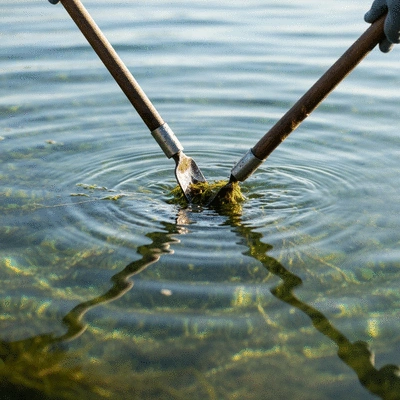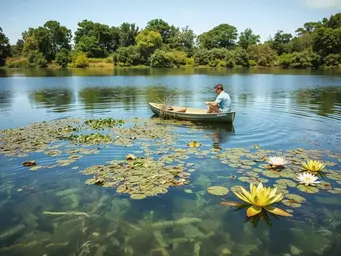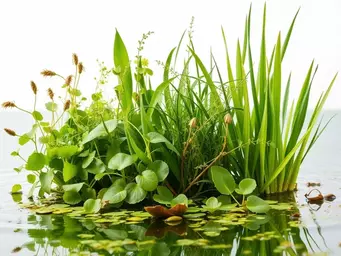Aquatic Weeds (Invasive)
- ✗ Rapid growth & reproduction
- ✗ Negative impact on native habitats
- ✗ Deplete oxygen levels

As we dive into the world of aquatic ecosystems, the complexity and importance of aquatic weeds become clear. Did you know that these seemingly innocuous plants can significantly impact the balance of our waterways? Recognizing their role is fundamental to fostering healthier environments.
This visual highlights the critical distinctions within aquatic ecosystems and the strategic approaches for effective management.
As we explore the fascinating world of aquatic ecosystems, it’s essential to understand the role of aquatic weeds and their impact on our waterways. Aquatic weeds are plants that grow in water bodies, and while some are beneficial, others can become invasive, disrupting the balance of the ecosystem. By recognizing these invaders, we can take steps to manage them effectively and protect our natural habitats.
At Aquatic Weed Solutions, we strive to broaden awareness of these vital issues. Understanding the distinctions between aquatic weeds and native species is the first step toward fostering a healthier environment!

Aquatic weeds are plants that thrive in water, often found in lakes, rivers, and ponds. While they can provide benefits like habitat and food for wildlife, some species can dominate and choke out native flora. Invasive aquatic plants, specifically, are non-native species that can spread rapidly, leading to ecological imbalances.
Here are some characteristics that help define aquatic weeds:
By identifying these traits, we can better manage their growth and mitigate their effects on ecosystems.
Some of the most common invasive aquatic plants include:
These species can pose significant threats to local ecosystems, making their management crucial for maintaining biodiversity. For an in-depth understanding of the challenges posed by aquatic invasive plants, you can refer to this study on aquatic invasive plant management.
A healthy aquatic ecosystem is defined by its ability to sustain diverse plant and animal life. Key indicators include clear water, balanced nutrient levels, and the presence of native species. Maintaining this balance is critical for ecological resilience, as it allows the ecosystem to adapt to changes.
Some components that contribute to a healthy ecosystem are:
Recognizing these components helps us in our mission to educate communities about sustainable practices that protect these vital ecosystems!
Native aquatic habitats serve several essential functions, including:
By maintaining these habitats, we foster biodiversity and ensure that ecosystems remain vibrant and productive.
Biodiversity is the cornerstone of a healthy ecosystem. The variety of species within an ecosystem contributes to its resilience, allowing it to withstand disturbances and adapt to changes. Diverse ecosystems can provide services such as pollination, water purification, and habitat stability.
Key benefits of biodiversity include:
Promoting biodiversity is crucial for the long-term health of our aquatic environments.
The loss of biodiversity can lead to devastating consequences for aquatic ecosystems. It can result in diminished ecosystem services, increased vulnerability to invasive species, and even collapse of habitats. As an ecologist, I’ve witnessed firsthand how these losses can disrupt community dynamics and ecological balance. For further reading on this topic, this article on species loss and ecosystem services provides valuable insights.
We need to recognize the signs of biodiversity loss and take proactive steps to protect and restore our aquatic habitats. Together, we can work toward a future where our waterways flourish!
According to recent studies, invasive aquatic plants can reduce biodiversity by up to 50% in affected ecosystems. This significant impact highlights the urgency of effective management strategies for aquatic weeds.
Managing invasive aquatic weeds effectively is crucial for protecting our precious ecosystems. At Aquatic Weed Solutions, we understand that a strategic approach is necessary for successful management and long-term sustainability. By employing various techniques, we can significantly reduce the impact of these invasive species and help restore balance to our waterways!
When we discuss control methods, it’s essential to focus on innovative restoration techniques and community involvement. There’s a lot we can achieve when we work together, and a community-driven approach ensures the integration of local knowledge and resources. This review on biological control of invasive aquatic plants offers additional perspectives on current management strategies.
There are several effective methods for controlling invasive aquatic weeds, each tailored to specific situations. Here’s a quick overview of some of the most successful techniques:
Each of these methods can be effective, but remember that a combination of approaches often yields the best results. It’s essential to assess your unique waterway conditions to choose the right strategy.

Innovative restoration techniques, such as using biological control agents, are increasingly becoming popular among ecologists and waterway managers. These agents work with nature to reduce invasive weed populations without resorting to harsh chemicals. For example, certain insects target specific aquatic plants, helping to naturally bring their numbers down.
Engaging the community in these efforts not only helps with management but also fosters a sense of stewardship. At Aquatic Weed Solutions, we encourage educational workshops where community members can learn about native species and the importance of maintaining ecological balance.
Community involvement plays a critical role in managing invasive aquatic weeds effectively. Working together, we can share resources, knowledge, and labor to tackle these challenges. Here are some ways communities can get involved:
When individuals come together to support their local waterways, they can make a significant impact! By fostering a collaborative spirit, we strengthen our collective efforts toward healthier aquatic ecosystems.
Invasive species management isn’t just about ecological balance; it also has economic implications. Understanding the costs associated with control and restoration can help stakeholders make informed decisions.
Investing in effective management strategies can save money in the long run by preventing further degradation of water quality and habitat. Healthy ecosystems are vital for local economies, especially in areas dependent on fishing, tourism, and recreation.
Implementing control methods incurs costs, but they are often outweighed by the benefits of restoring healthy ecosystems. Key expenses to consider include:
When we allocate resources wisely, the long-term health of our waterways can lead to thriving local economies!
Healthy aquatic ecosystems provide immense value to local communities. They support various economic activities, such as:
By protecting these ecosystems, we are also safeguarding our economic future. Investing in their health means investing in our community’s prosperity.
Effective lake and watershed management is essential for maintaining the health of aquatic ecosystems. Best practices in water management not only support biodiversity but also enhance the resilience of these environments against invasive species.
At Aquatic Weed Solutions, we advocate for sustainable water management policies that consider the entire watershed. Here are some best practices to implement:
These practices help maintain a balance between human activities and ecological health, ensuring our water resources remain vibrant for generations to come.
Shoreline stabilization is a critical component of watershed management. Techniques such as planting native grasses and installing bioengineered shorelines can combat erosion and provide habitat for wildlife. Some effective strategies include:
Enhancing habitats not only supports local wildlife but also improves water quality and combats invasive weeds. Let’s come together and take action to protect our valuable ecosystems!
Here is a quick recap of the important points discussed in the article:
Managing Aquatic Weeds Effectively

As we delve into the hidden challenges of our water ecosystems, understanding the role of aquatic we
Impact of Aquatic Weeds on Recreation

As we dive into the world of aquatic ecosystems, the presence of invasive aquatic weeds may not only
Understanding Aquatic Weed Varieties

What if understanding aquatic weeds could be the key to restoring our waterways? As we dive deeper i
Managing Aquatic Weeds Effectively
Impact of Aquatic Weeds on Recreation
Understanding Aquatic Weed Varieties
Integrated Aquatic Weed Management Methods
Integrated Approaches to Aquatic Weeds